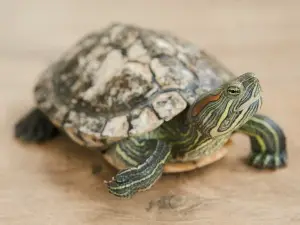
When damage appears on your turtle’s shell the health and well-being of the animal will ultimately be affected, this critical protective part turtle may be strong but it is not indestructible.
This article looks into all you need to know if your turtle has a hole in its shell.
Table of Contents
My turtle has a hole in its shell:
The shell is not only the turtle’s shield from the world but the shell is also the animal’s skeleton. It is attached to the body and is not separate so finding a hole in the animal’s shell can be quite concerning
Here is what you need to know if there is a hole in your turtle’s shell:
Trauma:
One of the reasons why your turtle’s shell may have a hole in it may be because of a traumatic experience like a fall, a collision, or an attack from a predator like a dog or a cat.
If the animal collides with a sharp object in its enclosure then the object may break the shell and this may result in a hole developing in the shell.
What to do:
Any openings in the shell will be an entry point for all sorts of pathogens like bacteria, fungi, or parasites. If these pathogens enter the shell then infections may develop.
If your pet is left untreated then this may compromise the animal’s health.
To avoid infections developing in the shell it is recommended that you keep the holes clean and keep an eye out for signs of infection in the area
You’d need to remove any hazards in your pet’s enclosure that may have caused the shell to break and form a hole. Also, keep any pets that may harm your pet away from the turtle and keep it from falling off of high heights.
Shell rot:
Another reason why there may be a hole in your turtle’s shell may be that the animal is suffering from a condition called shell rot.
This condition is also known as ulcerative shell disease and develops in turtles who are kept in dirty water. It can also develop in your pet if it lives in an area with a lack of a dry area or a dirty environment.
Shell rot can also occasionally look like angry red or orange ulcers that quickly spread across the shell. Holes will develop in the shells of turtles that have shell rot.
Shell rot is quite a serious condition and it is quite a common condition as well.
What to do:
If your pet is developing holes or dents in its shell then your pet is in late-stage shell rot.
Early-stage shell rot can be managed at home but late stage can’t. If your pet has late-stage shell rot then the reptile would need to be managed by a reptile vet.
The vet will not only manage the shell rot but will also offer your pet some pain medications and treatments if necessary
The pain median may be needed if the vet surgically removes some of the dead tissue caused by the shell rot. Antifungal or antibiotic treatments may be given by your vet to treat this condition.
You can keep your turtle’s shell rot at bay by ensuring that it is living in a clean and healthy space as well as making sure that the water temperature is appropriate for your turtle.
If you enjoyed this article then you may also be interested in other turtle/tortoise related articles. Here are some articles that you may be interested in: Is My Turtle Underweight?, Can Turtles Overheat?, My Turtle Keeps Scratching His Eyes, My Turtle Is Spitting Up Blood, My Turtle Only Laid One Egg, My Turtle Only Eats Shrimp, My Turtle Only Eats Lettuce, My Turtle Tank Smells Bad, Why Does My Turtle Tank Smell Bad After Cleaning?

